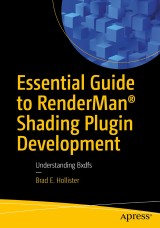Details

Essential Guide to RenderMan® Shading Plugin Development
Understanding Bxdfs|
62,99 € |
|
| Verlag: | Apress |
| Format: | |
| Veröffentl.: | 22.06.2023 |
| ISBN/EAN: | 9781484293928 |
| Sprache: | englisch |
Dieses eBook enthält ein Wasserzeichen.
Beschreibungen
<div>Understand the fundamentals of Bxdf plugins for RenderMan® 21+, both the technical details and API architecture. The main goal of the book is to enable technical artists, hobbyists, and students in using the noncommercial (NCR), free RenderMan® edition. </div><div> </div><div>RenderMan® is an industry standard for rendering software. It has been used for every Pixar film to date and numerous other projects. RenderMan® 21, and all subsequent versions, use Monte Carlo path tracing. This change has necessitated the use of C++ plugins in place of the RenderMan Shader Language (RSL). Because of this, writing Bxdfs now requires knowledge of Monte Carlo integration, probability density functions, and the RenderMan® C++ API. </div><div> </div><div><i>Essential Guide to RenderMan® Shading Plugin Development</i> specifically addresses writing RenderMan® C++ materials. It explores the mathematical models of representative Bxdfs while drawing parallels, when helpful, to earlier RSL implementations. It also includes an overview of Integrators, providing further context for modern RenderMan® programmable shading.</div><div> </div><div><b>What You Will Learn</b></div><div><ul><li>C++ development for Bxdfs</li><li>Fundamentals of the rendering equation</li><li>Monte Carlo integration</li></ul></div><div> </div><div><b>Who Is This Book For</b></div><div>Beginner plugin writers for RenderMan®, such as technical artists, students, or hobbyists who may already have experience with RSL or another shader language. More experienced C++ developers without knowledge of RenderMan® or Monte Carlo path tracing will benefit from the content as well. While some prior experience in computer graphics is helpful, the book provides background and references for further study.</div>
Chapter 1: RenderMan: Its History & Non-Commercial RenderMan<div>● Introduction to RenderMan</div><div>● RenderMan’s Historical Evolution </div><div>● Overview of Monte Carlo Path Tracing</div><div>● Installing NCR on Linux Machines</div><div>● Types of RenderMan® Plugins</div>● Procedural Patterns (Textures) via the Open Shading Language (OSL)<div>● Example of a Simple Diffuse BxDF Plugin</div><div>● Roadmap for the Remaining Book</div><div>● Summary</div><div><br></div><div>Chapter 2: What RenderMan Plugins Are Made Of: The C++ Language and Shared Object Files</div><div>● The C++ Language</div><div>● Compiling C++ Programs</div><div>● Args File</div><div>● Summary</div><div><br></div><div>Chapter 3: Radiometry & Bi-Directional Scattering Functions</div><div>● Radiometric Quantities</div><div>● Definition of the BxDF</div><div>● Rendering Equation</div><div>● Differential Solid Angle</div><div>● Change of Variables</div><div>● Summary</div><div><br></div><div>Chapter 4: Monte Carlo Path Tracing, Probability Distribution Functions, & Integrator Plugins</div><div>● Numerical Integration</div><div>● Probability Density Functions (PDFs)</div><div>● Variance for Error Determination </div><div>● Importance Sampling</div><div>● Approximating a PDF for Monte Carlo Integration</div><div>● Overview of Integrator Plugins</div><div>● Sample Counts</div><div>● Rays Traced</div><div>● Image Accuracy & Error</div>● Summary<div><br></div><div>Chapter 5: The RenderMan (Rix) API </div><div>● Important Classes for Shading Plugins</div><div>● Similarity with RSL’s “Built-In” Variables</div><div>● Difference Between Opacity and Presence</div><div>● Official Header File Documentation</div>● Utility Functions<div>● Summary</div><div><br></div><div>Chapter 6: BxDF Shader Plugin Examples 1: Canonical Examples of Reflection Regimes (BRDFs)</div><div>● Diffuse Reflection Model</div><div>● Specular Reflection Model</div><div>● Cosine Distribution Anisotropic Reflection Model</div>● Combining Models<div>● Summary</div><div><br></div><div>Chapter 7: BxDF Shader Plugin Examples 2: Advanced Examples of Scattering Regimes (BxDFs)</div><div>● Fresnel Coefficients</div><div>● Ward Anisotropy and Other Distributions</div><div>● Transmission Models</div><div>● Summary</div><div><br></div><div>Chapter 8: Debugging Shader Plugins</div><div>● Configuring Eclipse Project for Shader Development</div><div>● Using GDB</div><div>● Using PxrValidateBxDF Integrator for BxDF Plugin Debugging</div><div>● Summary</div><div><br></div>Chapter 9: The Args File and the Blender RenderMan Addon<div>● Arg File Contents</div><div>● Adding Variables to Args File</div><div>● Args File Location</div><div>● Use with Tools</div><div>● Summary</div><div><br></div><div>Chapter 10: Wrapup: Lights & Procedural OSL Pattern (Texture) Generation</div><div>● Light Plugins</div><div>● Custom Lights</div><div>● Other Plugins</div><div>● Open Shading Language </div><div>● Summary & Conclusions</div>
<b>Brad E. Hollister</b> holds a PhD from the University of California Santa Cruz in Computer Science and has extensive software development experience both professionally and in areas of Open Source, including BRL-CAD, VTK, and SCIRun. His research includes scientific visualization, virtual reality simulation for training, and computer graphics. He is also faculty advisor for the Open Source Mozilla Campus Club at the California State University Dominguez Hills.<p></p>
<p>Dr. Hollister has authored the following books:</p>
<p>● <i>Core Blender Development</i> </p>
● <i>A Concise Introduction to Scientific Visualization</i>
<p>Dr. Hollister has authored the following books:</p>
<p>● <i>Core Blender Development</i> </p>
● <i>A Concise Introduction to Scientific Visualization</i>
<div>Understand the fundamentals of Bxdf plugins for RenderMan® 21+, both the technical details and API architecture. The main goal of the book is to enable technical artists, hobbyists, and students in using the noncommercial (NCR), free RenderMan® edition. </div><div> </div><div>RenderMan® is an industry standard for rendering software. It has been used for every Pixar film to date and numerous other projects. RenderMan® 21, and all subsequent versions, use Monte Carlo path tracing. This change has necessitated the use of C++ plugins in place of the RenderMan Shader Language (RSL). Because of this, writing Bxdfs now requires knowledge of Monte Carlo integration, probability density functions, and the RenderMan® C++ API. </div><div> </div><div><i>Essential Guide to RenderMan® Shading Plugin Development</i> specifically addresses writing RenderMan® C++ materials. It explores the mathematical models of representative Bxdfs while drawing parallels, when helpful, to earlier RSL implementations. It also includes an overview of Integrators, providing further context for modern RenderMan® programmable shading.</div><div> </div><div>What You Will Learn</div><div><ul><li>C++ development for Bxdfs</li><li>Fundamentals of the rendering equation</li><li>Monte Carlo integration</li></ul></div>
<p>Provides an accessible introduction to writing custom shader plugins (BxDFs)</p><p>Teaches underlying mathematics of Monte Carlo integration and PDFs needed to write BxDF</p><p>Describes physical models of well-known BxDFs, visually outlining computations and physical interpretations</p>

















